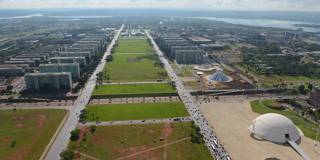Brasília’s urban design limitations offer a crucial lesson for many other places in the world. By resisting the temptation to fill every square inch of space on their paper, architects and urban planners can open up possibilities for people, changing times, and spontaneous chance to co-create the living city.
BRASÍLIA – Sixty-one years ago, Brasília emerged from Brazil’s hinterland. Developed on an empty savanna between 1956 and 1960, the city that replaced Rio de Janeiro as the country’s capital was a joint endeavor between urban planner Lúcio Costa and architect Oscar Niemeyer. With its winged shape, Brasília became a powerful symbol, because it represents one of the purest incarnations of the hopes, splendor, and ingenuousness of twentieth-century architecture. But it takes only a few hours here to see that this utopian metropolis – a UNESCO World Heritage Site since 1987 – is plagued by urban-planning defects.

BRASÍLIA – Sixty-one years ago, Brasília emerged from Brazil’s hinterland. Developed on an empty savanna between 1956 and 1960, the city that replaced Rio de Janeiro as the country’s capital was a joint endeavor between urban planner Lúcio Costa and architect Oscar Niemeyer. With its winged shape, Brasília became a powerful symbol, because it represents one of the purest incarnations of the hopes, splendor, and ingenuousness of twentieth-century architecture. But it takes only a few hours here to see that this utopian metropolis – a UNESCO World Heritage Site since 1987 – is plagued by urban-planning defects.